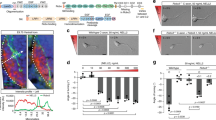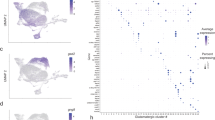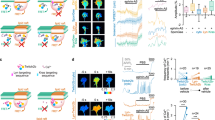Abstract
Axons rely on guidance cues to reach remote targets during nervous system development1. A well-studied model system for axon guidance is the retinotectal projection. The retina can be divided into halves; the nasal half, next to the nose, and the temporal half. A subset of retinal axons, those from the temporal half, is guided by repulsive cues expressed in a graded fashion in the optic tectum2,3, part of the midbrain. Here we report the cloning and functional characterization of a membrane-associated glycoprotein, which we call RGM (repulsive guidance molecule). This molecule shares no sequence homology with known guidance cues, and its messenger RNA is distributed in a gradient with increasing concentration from the anterior to posterior pole of the embryonic tectum. Recombinant RGM at low nanomolar concentration induces collapse of temporal but not of nasal growth cones and guides temporal retinal axons in vitro, demonstrating its repulsive and axon-specific guiding activity.
This is a preview of subscription content, access via your institution
Access options
Subscribe to this journal
Receive 51 print issues and online access
$199.00 per year
only $3.90 per issue
Buy this article
- Purchase on Springer Link
- Instant access to full article PDF
Prices may be subject to local taxes which are calculated during checkout




Similar content being viewed by others
References
Yu, T. W. & Bargmann, C. I. Dynamic regulation of axon guidance. Nature Neurosci. 4, 1169–1176 (2001)
Walter, J. et al. Recognition of position-specific properties of tectal cell membranes by retinal axons in vitro. Development 101, 685–696 (1987)
Walter, J., Müller, B. & Bonhoeffer, F. Axonal guidance by an avoidance mechanism. J. Physiol. (Paris) 84, 104–110 (1990)
Cheng, H. J. et al. Complementary gradients in expression and binding of ELF-1 and Mek4 in development of the topographic retinotectal projection map. Cell 82, 371–381 (1995)
Drescher, U. et al. In vitro guidance of retinal ganglion cell axons by RAGS, a 25 kDa tectal protein related to ligands for Eph receptor tyrosine kinases. Cell 82, 359–370 (1995)
Stahl, B. et al. Biochemical characterization of a putative axonal guidance molecule of the chick visual system. Neuron 5, 735–743 (1990)
Kozak, M. An analysis of 5′-noncoding sequences from 699 vertebrate messenger RNAs. Nucleic Acids Res. 15, 8125–8148 (1987)
Kyte, J. & Doolittle, R. F. A simple method for displaying the hydropathic character of a protein. J. Mol. Biol. 157, 105–132 (1982)
Ruoslahti, E. RGD and other recognition sequences for integrins. Annu. Rev. Cell Dev. Biol. 12, 697–715 (1996)
Sadler, J. E. Biochemistry and genetics of von Willebrand factor. Annu. Rev. Biochem. 67, 395–424 (1998)
Rathjen, F. G. et al. Membrane glycoproteins involved in neurite fasciculation. J. Cell Biol. 104, 343–353 (1987)
Cox, E. C., Müller, B. & Bonhoeffer, F. Axonal guidance in the chick visual system: posterior tectal membranes induce collapse of growth cones from the temporal retina. Neuron 4, 31–37 (1990)
Baier, H. & Bonhoeffer, F. Axon guidance by gradients of a target-derived component. Science 255, 472–475 (1992)
Wilm, M. et al. Femtomole sequencing of proteins from polyacrylamide gels by nanoelectrospray mass spectrometry. Nature 379, 466–469 (1996)
Acknowledgements
We thank P. Sonderegger for providing an embryonic chicken cDNA library, F. Rathjen for antibodies, H. Pachowsky for technical help; and S. Arber and B. Fackler for comments and suggestions. This work was supported by the Sonderforschungsbereich (B.K.M.) and the Danish National Research Foundation (M.M.).
Author information
Authors and Affiliations
Corresponding author
Ethics declarations
Competing interests
The authors declare that they have no competing financial interests.
Rights and permissions
About this article
Cite this article
Monnier, P., Sierra, A., Macchi, P. et al. RGM is a repulsive guidance molecule for retinal axons. Nature 419, 392–395 (2002). https://doi.org/10.1038/nature01041
Received:
Accepted:
Issue Date:
DOI: https://doi.org/10.1038/nature01041
This article is cited by
-
Transcriptomic characterization of the molecular mechanisms induced by RGMa during skeletal muscle nuclei accretion and hypertrophy
BMC Genomics (2022)
-
Increase in repulsive guidance molecule-a (RGMa) in lacunar and cortical stroke patients is related to the severity of the insult
Scientific Reports (2022)
-
Decreased DNA Methylation of RGMA is Associated with Intracranial Hypertension After Severe Traumatic Brain Injury: An Exploratory Epigenome-Wide Association Study
Neurocritical Care (2022)
-
Inhibition of repulsive guidance molecule-a protects dopaminergic neurons in a mouse model of Parkinson’s disease
Cell Death & Disease (2021)
-
Repulsive guidance molecule acts in axon branching in Caenorhabditis elegans
Scientific Reports (2021)
Comments
By submitting a comment you agree to abide by our Terms and Community Guidelines. If you find something abusive or that does not comply with our terms or guidelines please flag it as inappropriate.



